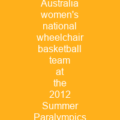The Paralympic Games: A Journey of Triumph and Inclusion
Imagine a world where athletes with disabilities are not just seen as individuals with limitations, but as champions in their own right. This is the essence of the Paralympic Games, an international multisport event that has grown from humble beginnings to become one of the largest and most inspiring sporting events on the planet.
The Genesis of a Movement
How did it all begin? The Paralympics started as a small gathering in 1948, when British World War II veterans came together to compete. This event, known today as the Stoke Mandeville Games, was founded by Dr. Ludwig Guttmann and has since evolved into an international phenomenon.
The Evolution of the Paralympics
From its early days in 1948, the Paralympic movement has seen significant milestones. The first official Paralympic Games were held in Rome in 1960, with athletes from 23 countries competing. Since then, the games have grown to include over 163 National Paralympic Committees and a wide range of sports.
The Paralympic Charter
The Paralympic Charter, established by the International Paralympic Committee (IPC), emphasizes equal treatment with non-disabled Olympic athletes. However, despite this commitment, the Paralympics still face a large funding gap compared to the Olympics.
A Global Celebration of Ability
The Paralympics are organized parallel to the Olympic Games and have become one of the largest international sporting events. The movement now emphasizes ability rather than disability, with 4,342 athletes from 159 countries participating in the Rio de Janeiro games.
Key Components of the Opening Ceremony
The opening ceremony is a spectacular event that starts with the host country’s flag and national anthem. Athletes then enter the stadium alphabetically according to their host country’s official language, followed by cultural displays and speeches from athletes, coaches, and judges.
Challenges and Milestones
The Paralympics have faced numerous challenges over the years, including media coverage and funding. However, there have also been significant milestones, such as the 2014 Winter Paralympics in Russia, which highlighted the contrast between Olympic and Paralympic achievements.
Medals Ceremonies
After each event, winners are awarded medals on a rostrum while their national flags are raised. This is a moment of pride for athletes who have overcome incredible odds to compete at the highest level.
The Future of Paralympic Sports
With ongoing efforts by the IPC and WADA to ensure fair play, the future looks bright for Paralympic sports. The inclusion of athletes with intellectual disabilities in 2012 was a significant step forward, but there is still work to be done to address concerns like gene doping.
The Role of Sponsors
Major sponsors have played a crucial role in supporting the Paralympics since 1992. Recent games have seen increased media coverage and record-breaking audience numbers, thanks to initiatives by broadcasters like Channel 4.

Conclusion
The Paralympic Games are a testament to the human spirit and the power of inclusion. From its humble beginnings in 1948, this movement has grown into an international celebration of ability over disability. As we look to the future, the Paralympics continue to inspire us with their dedication to equal treatment and fair play.
You want to know more about Paralympic Games?
This page is based on the article Paralympic Games published in Wikipedia (retrieved on December 11, 2024) and was automatically summarized using artificial intelligence.







